Commentary
The future is phygital: Insights to meet in-restaurant and digital expectations
Tillster 2023 Phygital Index cites touchpoints to meet customer expectations, drive engagement.
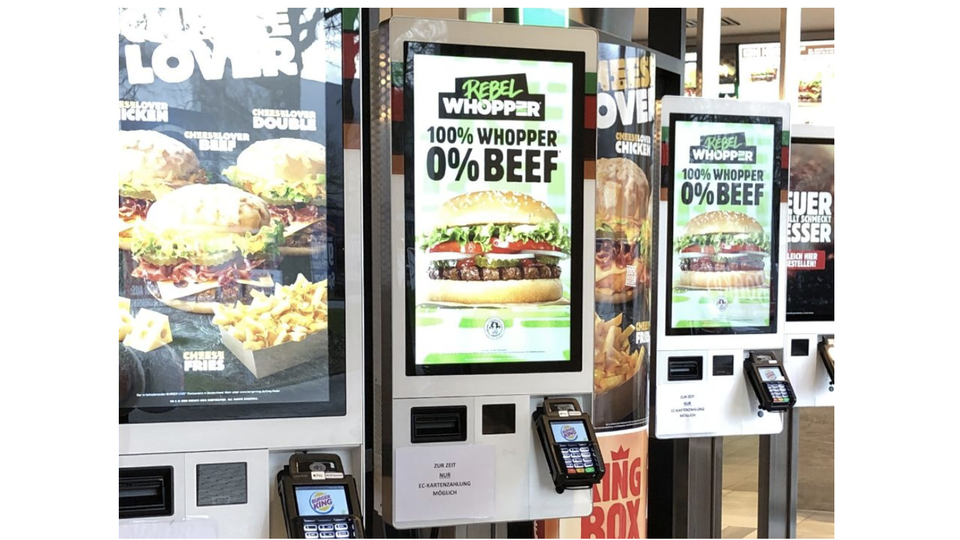
August 23, 2023 | by Hope Neiman, Tillster
As we emerge from the COVID-19 pandemic, consumers no longer want solely physical or digital interactions. They crave both. This fusion of physical and digital experiences, known as phygital, is happening all around us.
In retail, we use our phones to order products for in-store pickup and pay using mobile wallets. In hospitality, we explore hotels through 3D tours, book online, update our arrival times on our phones and check in with concierges in person.
Nowhere is the demand for phygital experiences more pronounced than in the restaurant industry, particularly in quick-service restaurants and fast-casual establishments, where convenience reigns supreme.
Diners seek the hospitality, human connection and ambiance of physical experiences while leveraging the self-service, personalized capabilities of digital interfaces.
To learn more about diners' evolving expectations, Tillster, a global provider of digital ordering solutions for restaurants, conducted a survey of more than 1,000 QSR and fast-casual customers for our fifth annual consumer index report. Our 2023 Phygital Index report delves into what diners seek from their digital ordering experiences, encompassing delivery, self-service kiosks, digital ordering, loyalty programs, and more.
Phygital touchpoint No. 1: Self-service kiosks
Self-service kiosks provide a convenient digital interface for diners at physical QSR locations to order food and drinks, make payments and print out receipts, whether they choose to dine in or carry out.
Even though not all QSRs and fast-casual restaurants offer kiosk systems, a significant number of consumers use the option when available. In fact, over a third of consumers (34%) indicated they'd like restaurants to have more self-service kiosks available, highlighting the demand for this phygital dining experience.
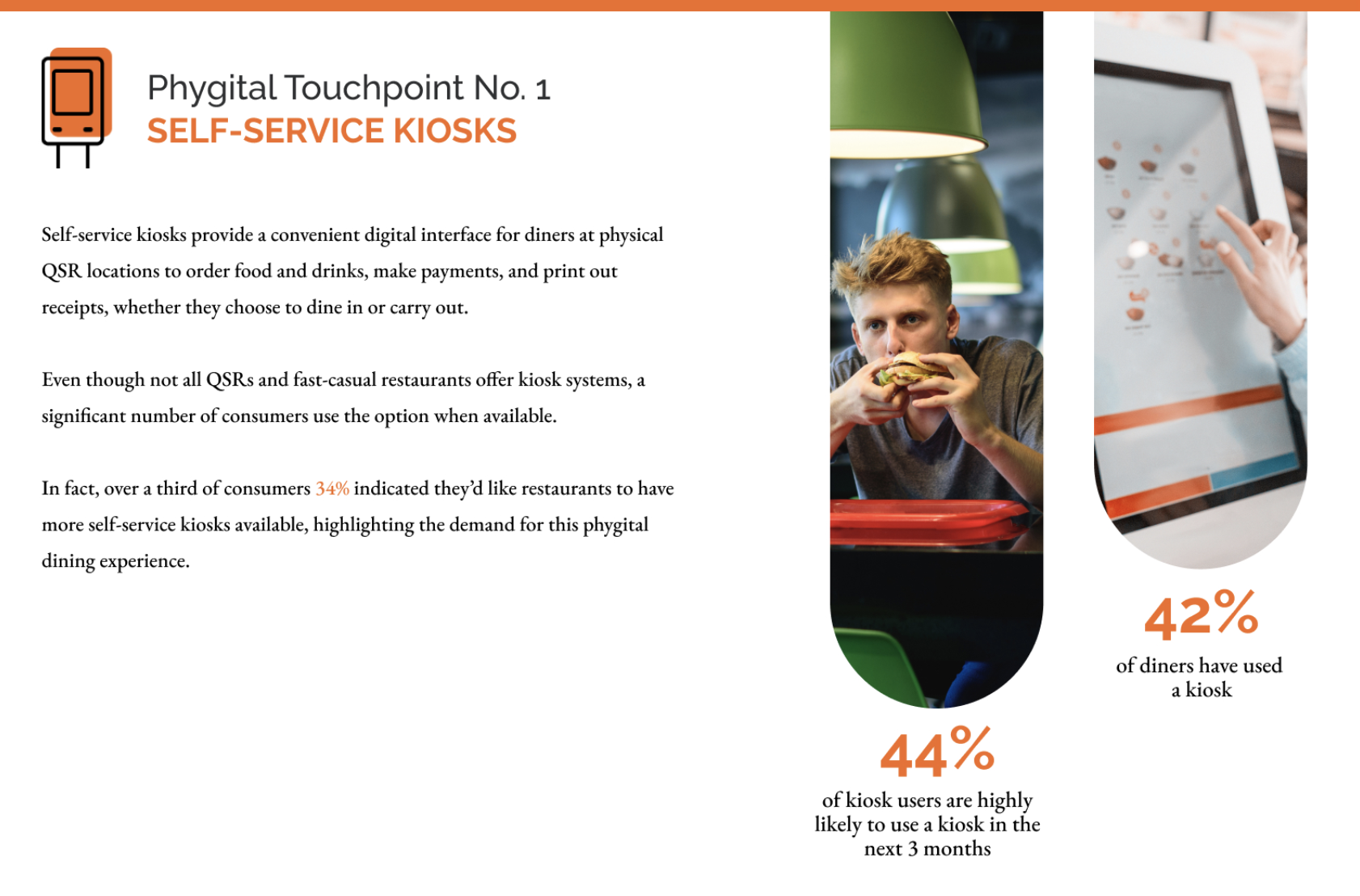 |
Close to half (42%) of diners have used a kiosk, 22% have used a kiosk in the past three months and 44% of kiosk users are highly likely to use a kiosk in the next three months.
Although some diners used kiosks during the pandemic to avoid contact with others, it seems like this habit is here to stay. Of respondents who have used a kiosk in the past three months, the majority are regular users: 88% use a kiosk at least once a month — with nearly half (47%) doing so at least once a week.
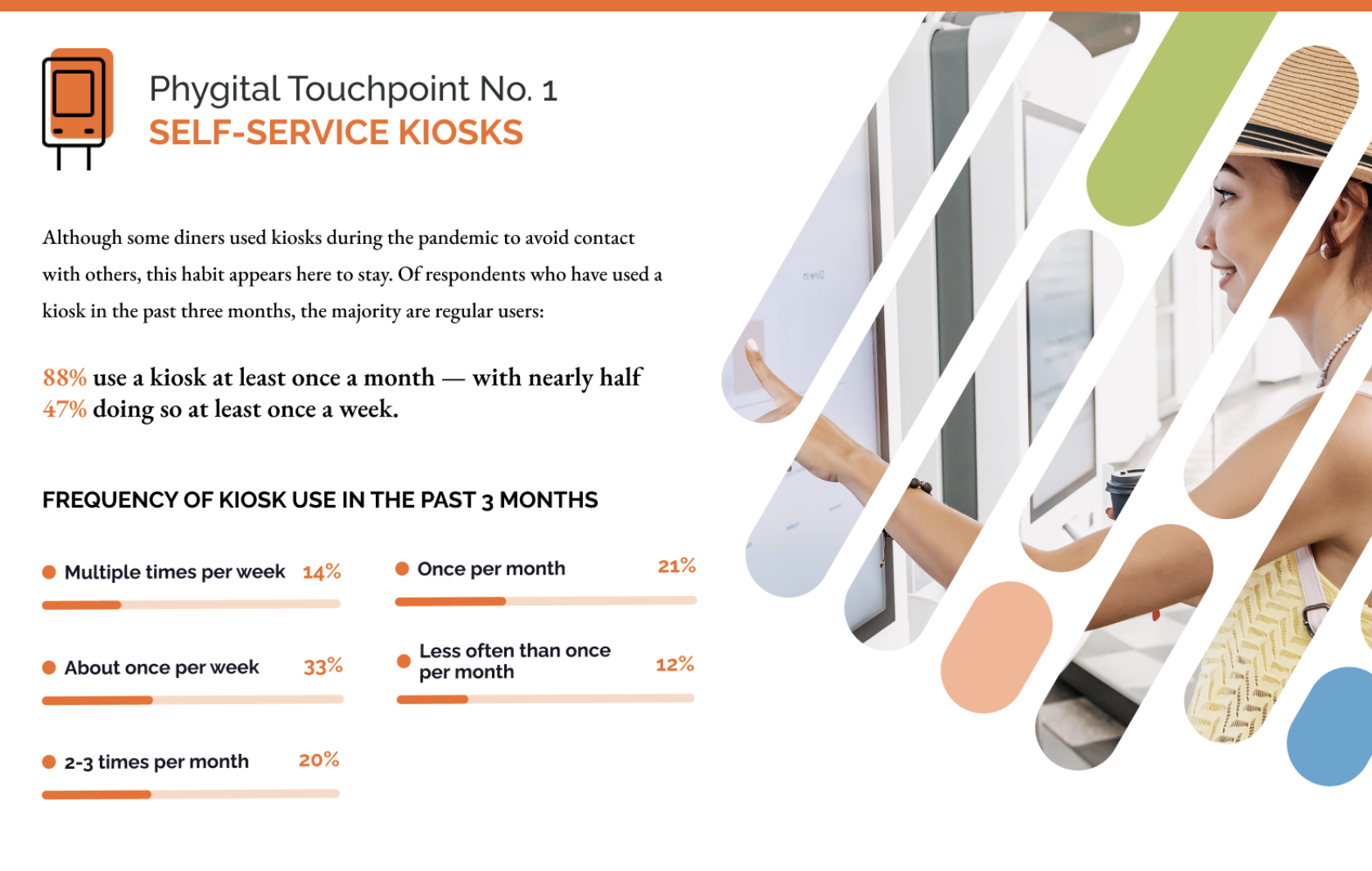 |
Distinct user types
We've identified two distinct types of kiosk users: beeliners, who value speed and convenience, and explorers, who value taking their time to browse.
QSRs need to ensure their kiosks can satisfy both types of users.
Beeliners want to make their orders quickly and easily, while explorers want to dive deep into the menu and customize their meals.
Top reasons diners who have used kiosk in the past three months prefer kiosks are as follows:
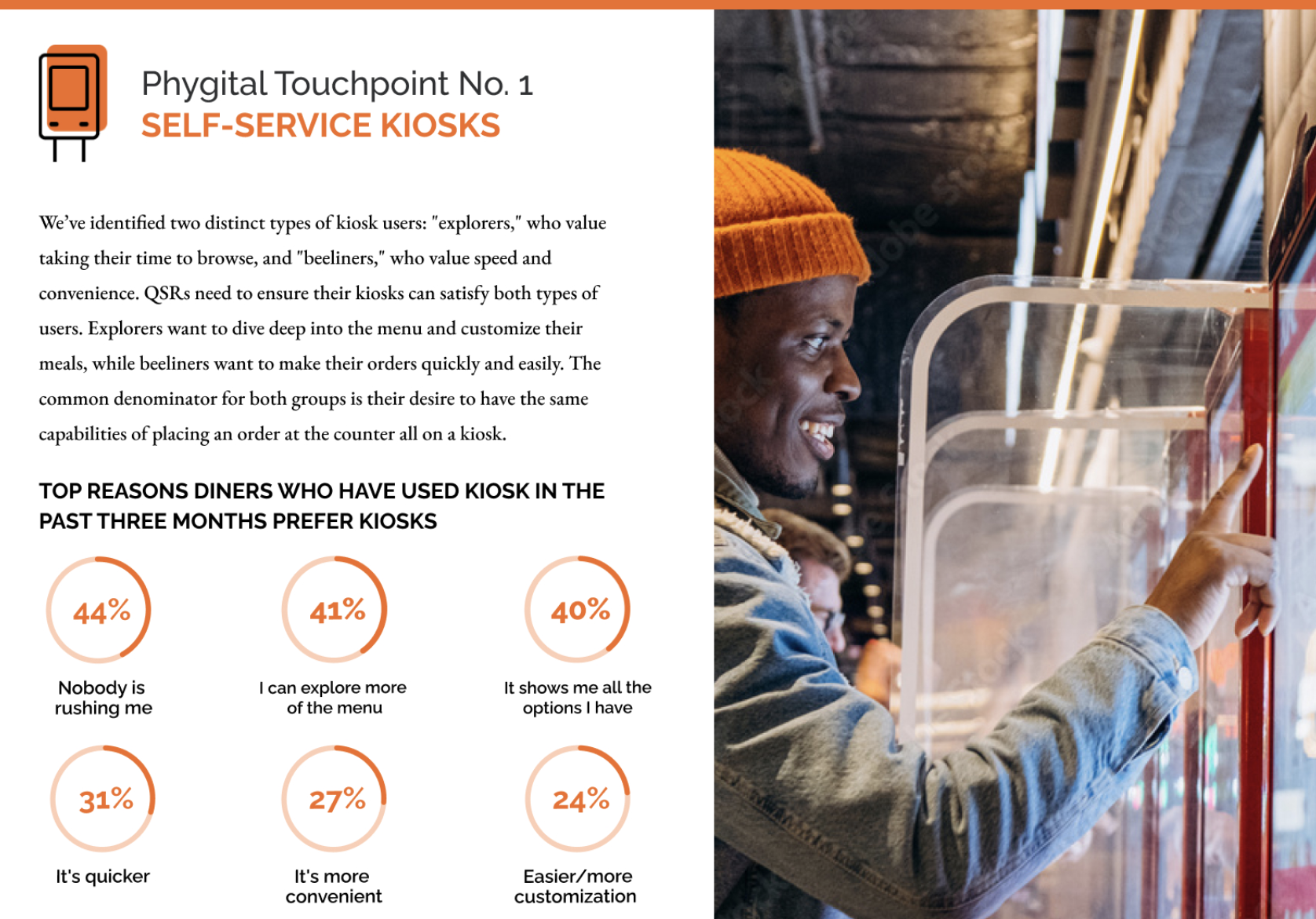 |
A win-win for customers and restaurants
Self-service kiosks can benefit QSRs in a number of ways. First, they free up staff to focus on other tasks, such as preparing food and keeping the restaurant tidy.
Second, kiosks can help diners discover new items on the menu, which can lead to larger, more lucrative orders. In fact, three-quarters of diners have ordered more items than they originally intended after ordering from a self-service kiosk.
A 59% majority of kiosk users have been pleasantly surprised by new menu and customization options as a result of using a kiosk.
A 56% majority have also occasionally reported ordering more items than originally intended, while 18% do so regularly and 25% never have.
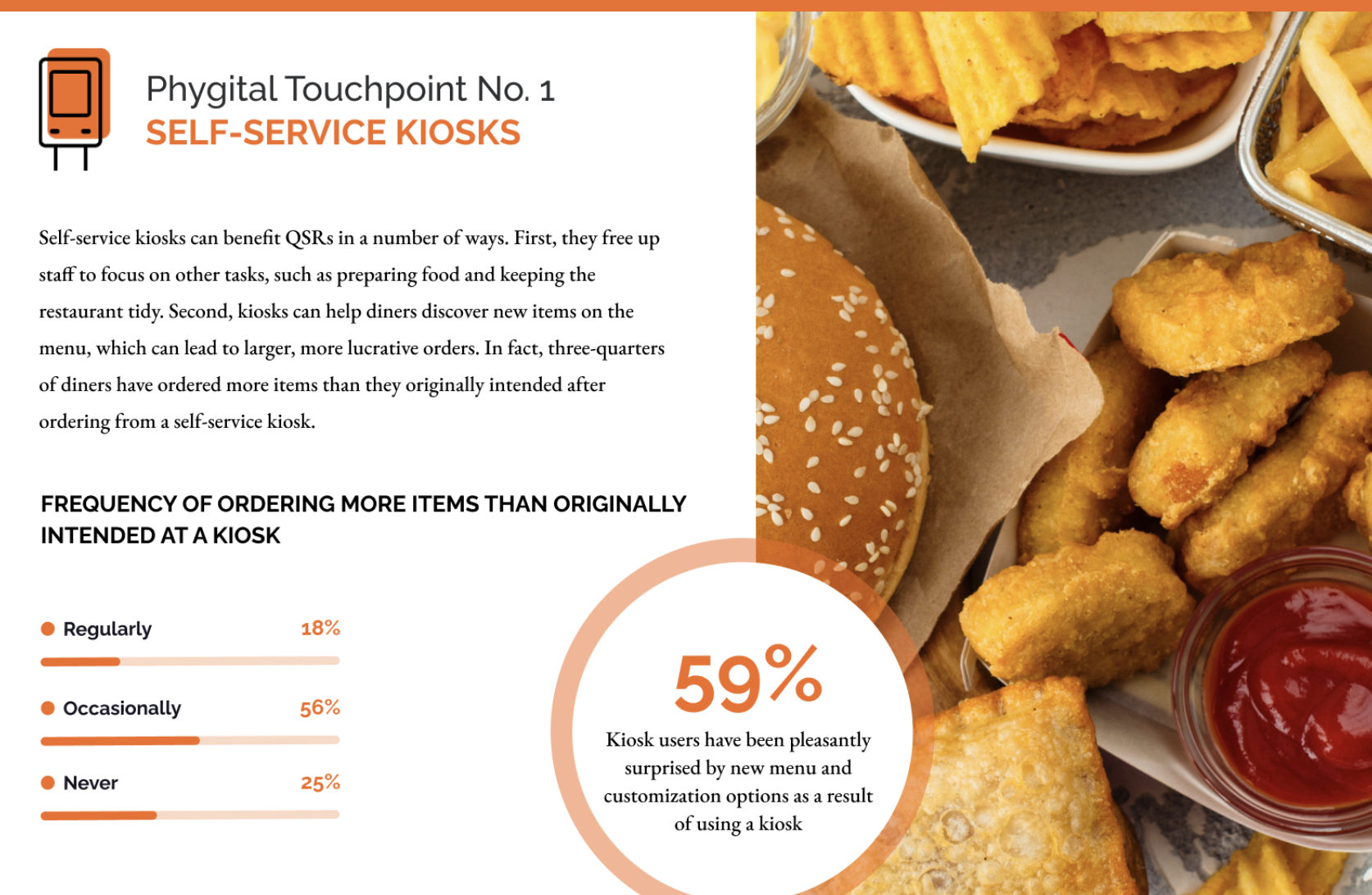 |
Customer expectations
Kiosks need to be more than just a vehicle for placing orders. Users have high expectations and they want the experience to be as good as or even better than ordering directly from an employee.
To encourage increased use, QSRs need to ensure kiosks offer an intuitive user experience and provide features that make the ordering process efficient and engaging. This could include the ability to scan loyalty QR codes, quickly access previous orders or make personalized recommendations.
A 77% majority expect to be able to do everything at a kiosk they could do at the counter.
More than half (53%) would use kiosks more frequently if there were shorter lines and 47% would use kiosks more frequently if there were special offers.
Asked what actions kiosk users expect to be able to do at a kiosk, 86% said customize orders, 71% said earn and redeem loyalty rewards, 40% said use multiple language options, 36% said access previous orders and 35% said receive personalized menu recommendations.
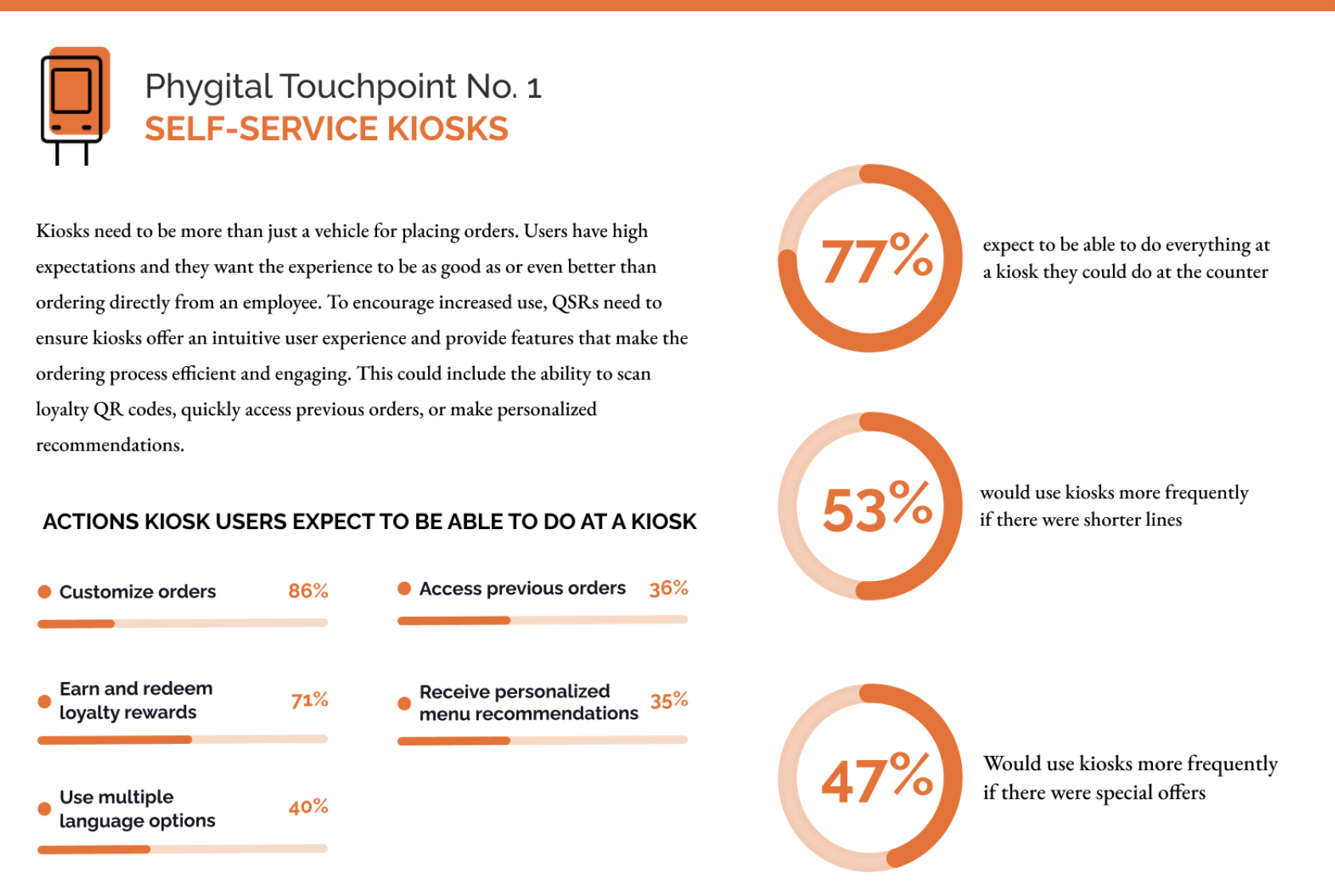 |
The common denominator: Personalization and loyalty
Diners crave phygital experiences in part due to two key factors: personalized recommendations and seamless integration with loyalty programs. These features — commonly incorporated in phygital touchpoints — play a crucial role in delivering more cost-effective and streamlined customer experiences that help diners feel valued for their patronage.
A 92% majority would like to receive some type of personalization from QSRs while 33% said it's important for QSRs to personalize the ordering experience to their past orders or preferences and 32% plan to order more frequently from QSRs offering personalized messaging, promotions or recommendations in the next six months.
Enrolling customers in loyalty programs provides QSRs with a powerful tool for personalization. It enables QSRs to gather customer data, tailor offerings and communications to individual preferences and create personalized incentives that encourage repeat visits.
More than a third (36%) of diners would be interested in trying a personalized menu.
Diners want personalized experiences to be delivered via email, 53% mobile app, 49%, text, 37% and website, 20%.
Asked what personalized ordering experiences diners expect, order customization and loyalty anniversaries both received a 48% response, followed by:
- Receiving tailored loyalty offers, 45%.
- Remembering my preferred order, 38%.
- Remembering my name, 30%.
- Remembering my address, 23%.
Despite the desire for personalized experiences among diners, many restaurants are falling short in delivering on this expectation. Lack of personalization or improper implementation can have negative consequences for restaurants, resulting in missed opportunities and frustration among customers.
Asked how often they receive personalized recommendations or promotions, 11% of diners said frequently, 46% said sometimes, 26% said rarely and 17% said never.
Nearly a quarter (21%) have abandoned an order because the ordering experience was not personalized to their preferences while 20% said they feel some level of frustration if they receive offers or promotions that are not relevant to their past orders or preferences.
Harmonious technology is essential for effective personalization and loyalty programs. Without a seamless integration across channels, QSRs may not be able to collect the data they need to understand their guests' behavior and preferences.
By investing in a robust tech infrastructure, QSRs can enable personalized experiences and reap several important benefits, like positive customer testimonials, more lucrative orders and lifelong customer loyalty.
A 56% majority are more likely to recommend a fast-food or fast-casual restaurant to a friend or family member based on a positive personalized ordering experience while 51% have tried a new item due to receiving personalized recommendations, 53% have taken advantage of a personalized loyalty offer and 42% are more likely to pay extra to customize a free item.
The future is phygital
The pandemic accelerated the adoption of digital ordering solutions, but the demand for physical dining experiences remains. Consumers want a variety of ordering options depending on their mood and circumstances, expecting both self-service capabilities and in-person service.
Whether diners interact with a brand digitally or in person, they expect a seamless and efficient experience that is tailored to their preferences and awards them for their loyalty. Diners reward
QSRs that can deliver these experiences with their allegiance and dollars.
Digital solutions like kiosks and mobile ordering play a crucial role in optimizing operations and delivering exceptional dining experiences. These phygital touchpoints have become indispensable in meeting customer expectations, driving engagement and cultivating long-term relationships with diners.
Hope Neiman is chief marketing officer at Tillster, a provider of pont-of-sale software for the restaurant and retail industries.
Images provided by Tillster.






